Health Literacy and Person-Centered Care Plan for Nellie
VerifiedAdded on 2022/09/18
|6
|1472
|74
Essay
AI Summary
This essay explores the critical role of health literacy in nursing, emphasizing its importance in promoting patient well-being and understanding of their health conditions. It delves into the concept of person-centered care, highlighting the nurse's role in providing health education and respecting patients' rights to make informed decisions. The essay presents a detailed care plan for a patient named Nellie, focusing on her understanding of warfarin. The plan includes strategies like active listening, empathy, and culturally competent education to address Nellie's concerns and improve her adherence to the medication. The goal is to enhance Nellie's knowledge of warfarin's role in her health, ensuring she continues the medication and feels comfortable communicating with her nurse. The essay also discusses the broader impact of health literacy on community competence, influencing demographic data and reducing hospital readmissions. It references key studies and frameworks to support the importance of health promotion initiatives in healthcare.
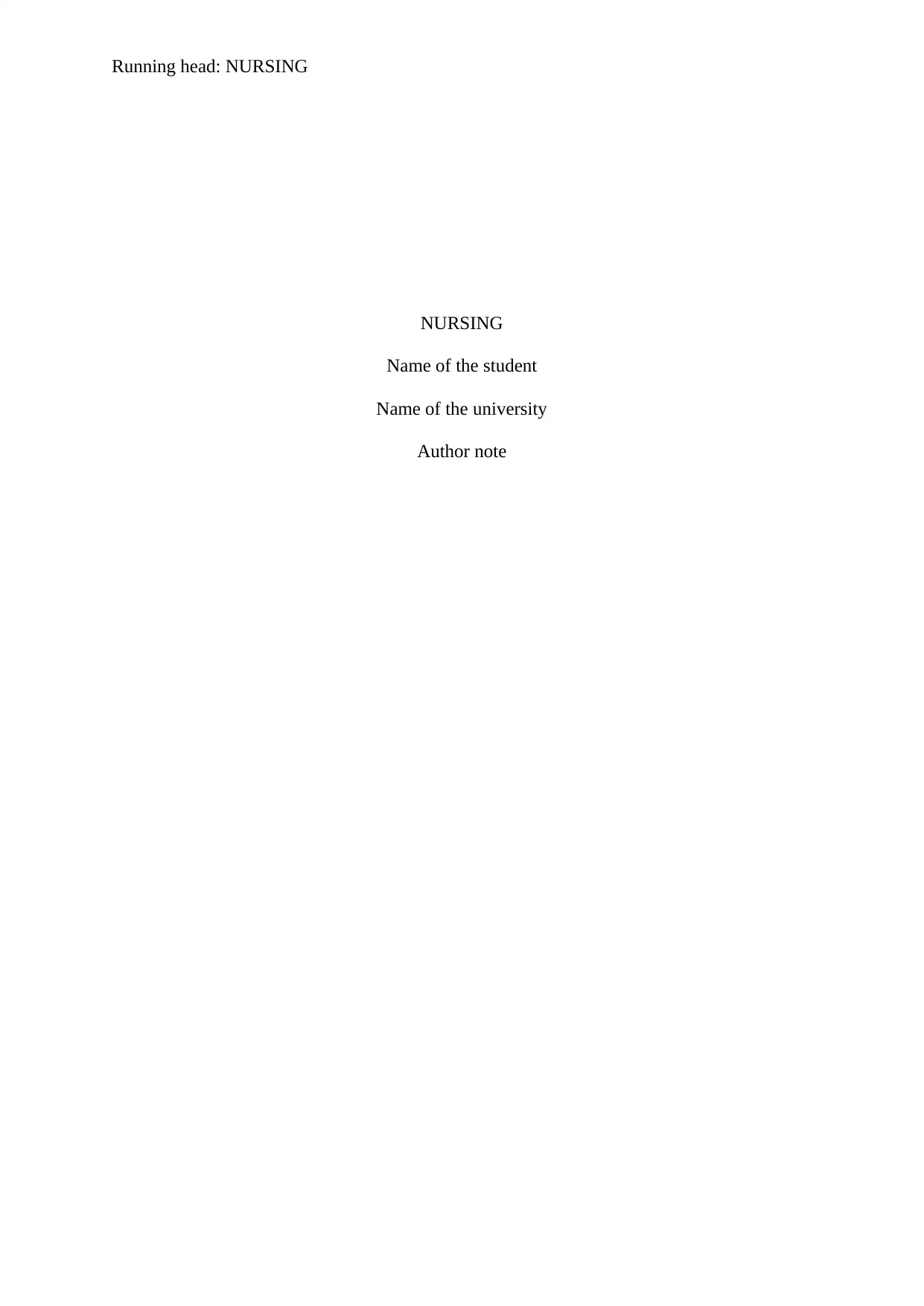
Running head: NURSING
NURSING
Name of the student
Name of the university
Author note
NURSING
Name of the student
Name of the university
Author note
Paraphrase This Document
Need a fresh take? Get an instant paraphrase of this document with our AI Paraphraser
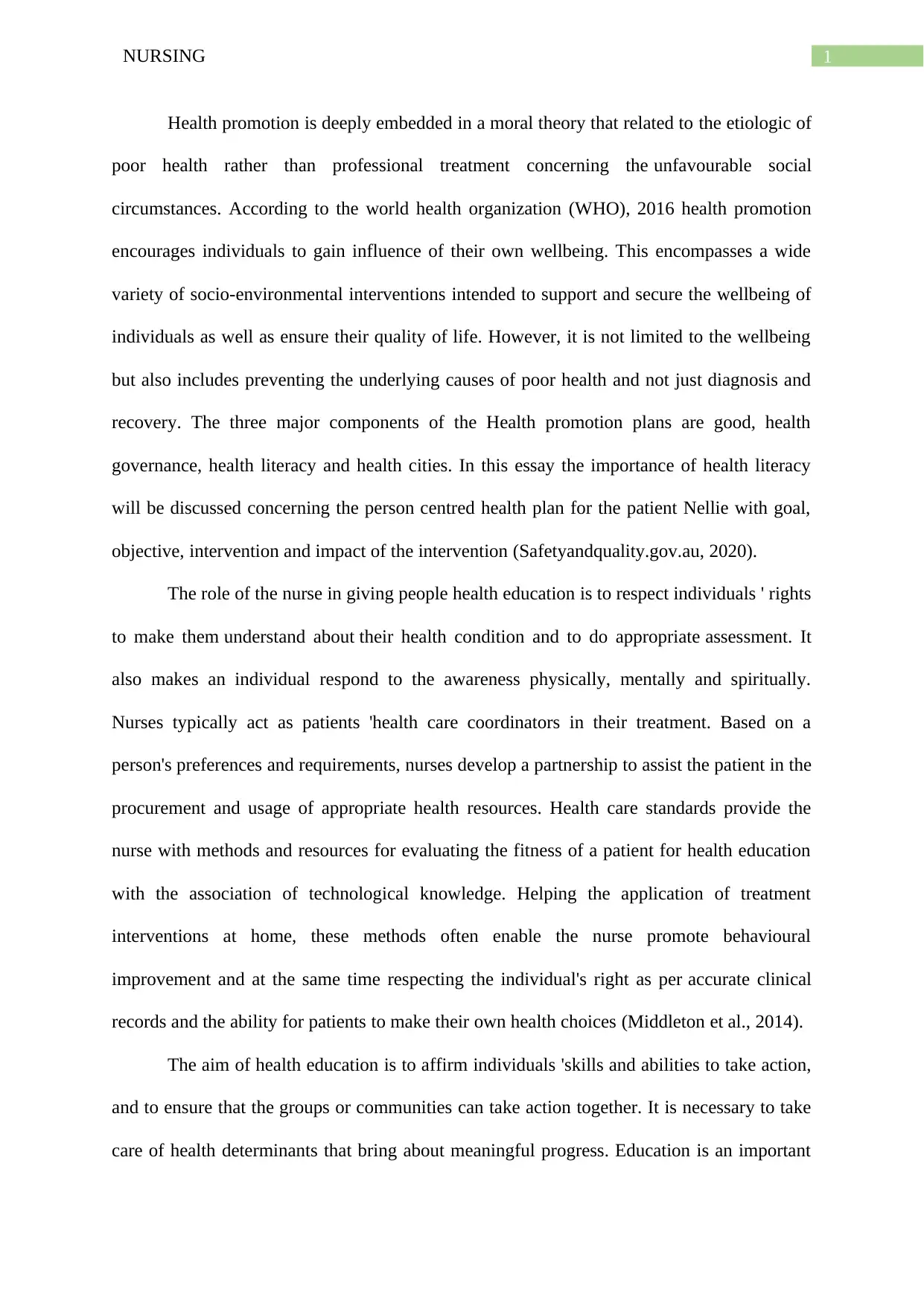
1NURSING
Health promotion is deeply embedded in a moral theory that related to the etiologic of
poor health rather than professional treatment concerning the unfavourable social
circumstances. According to the world health organization (WHO), 2016 health promotion
encourages individuals to gain influence of their own wellbeing. This encompasses a wide
variety of socio-environmental interventions intended to support and secure the wellbeing of
individuals as well as ensure their quality of life. However, it is not limited to the wellbeing
but also includes preventing the underlying causes of poor health and not just diagnosis and
recovery. The three major components of the Health promotion plans are good, health
governance, health literacy and health cities. In this essay the importance of health literacy
will be discussed concerning the person centred health plan for the patient Nellie with goal,
objective, intervention and impact of the intervention (Safetyandquality.gov.au, 2020).
The role of the nurse in giving people health education is to respect individuals ' rights
to make them understand about their health condition and to do appropriate assessment. It
also makes an individual respond to the awareness physically, mentally and spiritually.
Nurses typically act as patients 'health care coordinators in their treatment. Based on a
person's preferences and requirements, nurses develop a partnership to assist the patient in the
procurement and usage of appropriate health resources. Health care standards provide the
nurse with methods and resources for evaluating the fitness of a patient for health education
with the association of technological knowledge. Helping the application of treatment
interventions at home, these methods often enable the nurse promote behavioural
improvement and at the same time respecting the individual's right as per accurate clinical
records and the ability for patients to make their own health choices (Middleton et al., 2014).
The aim of health education is to affirm individuals 'skills and abilities to take action,
and to ensure that the groups or communities can take action together. It is necessary to take
care of health determinants that bring about meaningful progress. Education is an important
Health promotion is deeply embedded in a moral theory that related to the etiologic of
poor health rather than professional treatment concerning the unfavourable social
circumstances. According to the world health organization (WHO), 2016 health promotion
encourages individuals to gain influence of their own wellbeing. This encompasses a wide
variety of socio-environmental interventions intended to support and secure the wellbeing of
individuals as well as ensure their quality of life. However, it is not limited to the wellbeing
but also includes preventing the underlying causes of poor health and not just diagnosis and
recovery. The three major components of the Health promotion plans are good, health
governance, health literacy and health cities. In this essay the importance of health literacy
will be discussed concerning the person centred health plan for the patient Nellie with goal,
objective, intervention and impact of the intervention (Safetyandquality.gov.au, 2020).
The role of the nurse in giving people health education is to respect individuals ' rights
to make them understand about their health condition and to do appropriate assessment. It
also makes an individual respond to the awareness physically, mentally and spiritually.
Nurses typically act as patients 'health care coordinators in their treatment. Based on a
person's preferences and requirements, nurses develop a partnership to assist the patient in the
procurement and usage of appropriate health resources. Health care standards provide the
nurse with methods and resources for evaluating the fitness of a patient for health education
with the association of technological knowledge. Helping the application of treatment
interventions at home, these methods often enable the nurse promote behavioural
improvement and at the same time respecting the individual's right as per accurate clinical
records and the ability for patients to make their own health choices (Middleton et al., 2014).
The aim of health education is to affirm individuals 'skills and abilities to take action,
and to ensure that the groups or communities can take action together. It is necessary to take
care of health determinants that bring about meaningful progress. Education is an important
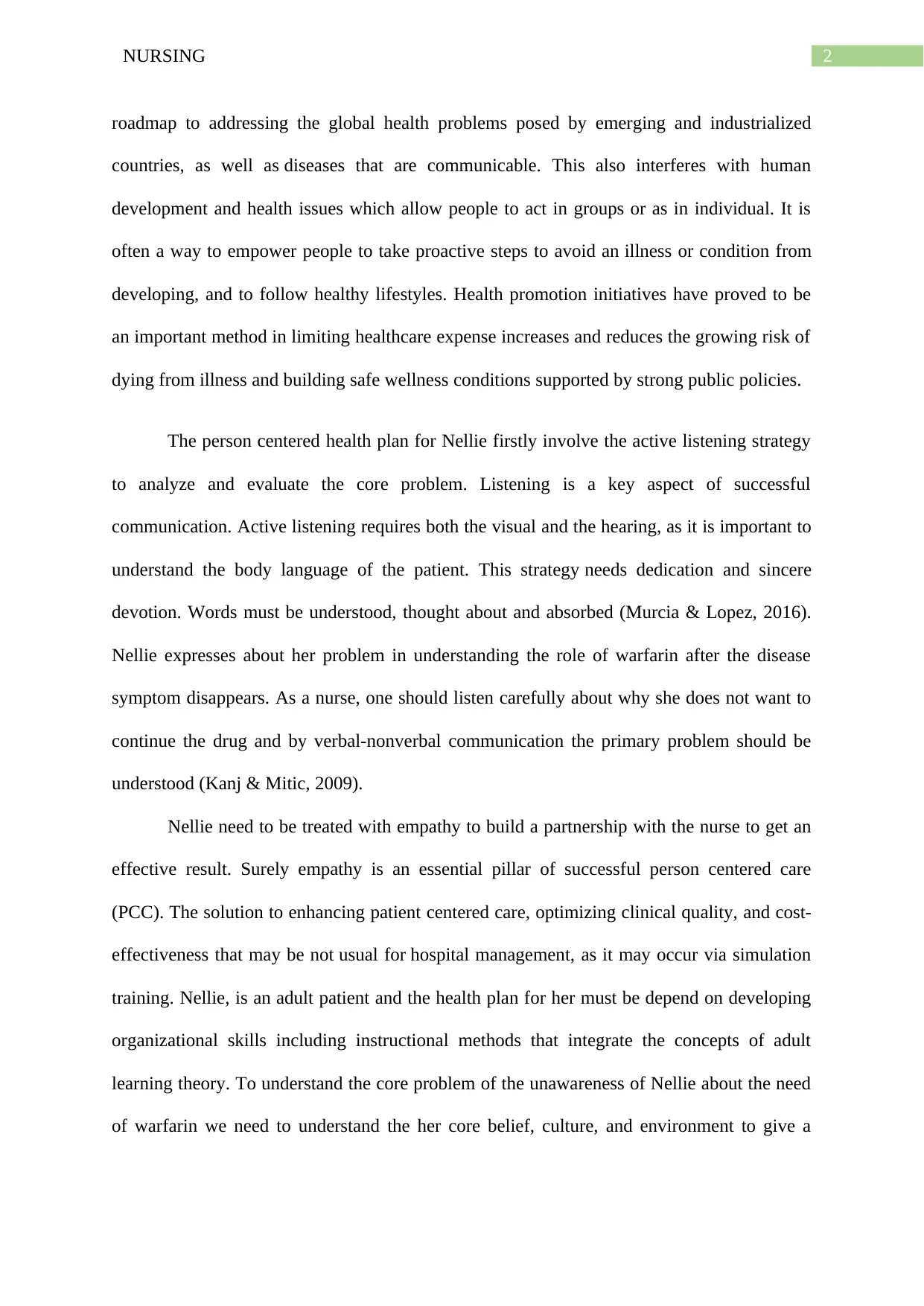
2NURSING
roadmap to addressing the global health problems posed by emerging and industrialized
countries, as well as diseases that are communicable. This also interferes with human
development and health issues which allow people to act in groups or as in individual. It is
often a way to empower people to take proactive steps to avoid an illness or condition from
developing, and to follow healthy lifestyles. Health promotion initiatives have proved to be
an important method in limiting healthcare expense increases and reduces the growing risk of
dying from illness and building safe wellness conditions supported by strong public policies.
The person centered health plan for Nellie firstly involve the active listening strategy
to analyze and evaluate the core problem. Listening is a key aspect of successful
communication. Active listening requires both the visual and the hearing, as it is important to
understand the body language of the patient. This strategy needs dedication and sincere
devotion. Words must be understood, thought about and absorbed (Murcia & Lopez, 2016).
Nellie expresses about her problem in understanding the role of warfarin after the disease
symptom disappears. As a nurse, one should listen carefully about why she does not want to
continue the drug and by verbal-nonverbal communication the primary problem should be
understood (Kanj & Mitic, 2009).
Nellie need to be treated with empathy to build a partnership with the nurse to get an
effective result. Surely empathy is an essential pillar of successful person centered care
(PCC). The solution to enhancing patient centered care, optimizing clinical quality, and cost-
effectiveness that may be not usual for hospital management, as it may occur via simulation
training. Nellie, is an adult patient and the health plan for her must be depend on developing
organizational skills including instructional methods that integrate the concepts of adult
learning theory. To understand the core problem of the unawareness of Nellie about the need
of warfarin we need to understand the her core belief, culture, and environment to give a
roadmap to addressing the global health problems posed by emerging and industrialized
countries, as well as diseases that are communicable. This also interferes with human
development and health issues which allow people to act in groups or as in individual. It is
often a way to empower people to take proactive steps to avoid an illness or condition from
developing, and to follow healthy lifestyles. Health promotion initiatives have proved to be
an important method in limiting healthcare expense increases and reduces the growing risk of
dying from illness and building safe wellness conditions supported by strong public policies.
The person centered health plan for Nellie firstly involve the active listening strategy
to analyze and evaluate the core problem. Listening is a key aspect of successful
communication. Active listening requires both the visual and the hearing, as it is important to
understand the body language of the patient. This strategy needs dedication and sincere
devotion. Words must be understood, thought about and absorbed (Murcia & Lopez, 2016).
Nellie expresses about her problem in understanding the role of warfarin after the disease
symptom disappears. As a nurse, one should listen carefully about why she does not want to
continue the drug and by verbal-nonverbal communication the primary problem should be
understood (Kanj & Mitic, 2009).
Nellie need to be treated with empathy to build a partnership with the nurse to get an
effective result. Surely empathy is an essential pillar of successful person centered care
(PCC). The solution to enhancing patient centered care, optimizing clinical quality, and cost-
effectiveness that may be not usual for hospital management, as it may occur via simulation
training. Nellie, is an adult patient and the health plan for her must be depend on developing
organizational skills including instructional methods that integrate the concepts of adult
learning theory. To understand the core problem of the unawareness of Nellie about the need
of warfarin we need to understand the her core belief, culture, and environment to give a
⊘ This is a preview!⊘
Do you want full access?
Subscribe today to unlock all pages.

Trusted by 1+ million students worldwide
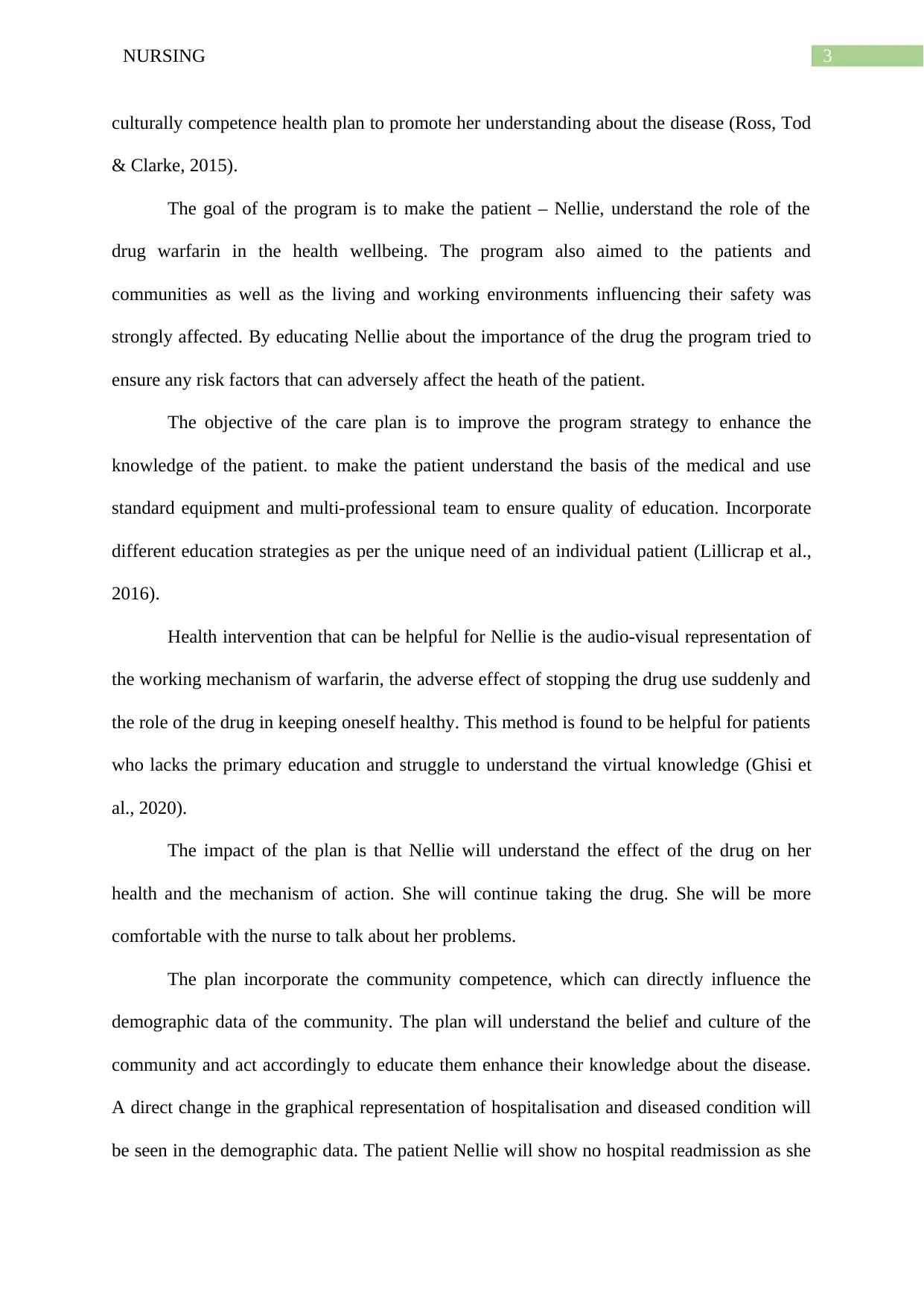
3NURSING
culturally competence health plan to promote her understanding about the disease (Ross, Tod
& Clarke, 2015).
The goal of the program is to make the patient – Nellie, understand the role of the
drug warfarin in the health wellbeing. The program also aimed to the patients and
communities as well as the living and working environments influencing their safety was
strongly affected. By educating Nellie about the importance of the drug the program tried to
ensure any risk factors that can adversely affect the heath of the patient.
The objective of the care plan is to improve the program strategy to enhance the
knowledge of the patient. to make the patient understand the basis of the medical and use
standard equipment and multi-professional team to ensure quality of education. Incorporate
different education strategies as per the unique need of an individual patient (Lillicrap et al.,
2016).
Health intervention that can be helpful for Nellie is the audio-visual representation of
the working mechanism of warfarin, the adverse effect of stopping the drug use suddenly and
the role of the drug in keeping oneself healthy. This method is found to be helpful for patients
who lacks the primary education and struggle to understand the virtual knowledge (Ghisi et
al., 2020).
The impact of the plan is that Nellie will understand the effect of the drug on her
health and the mechanism of action. She will continue taking the drug. She will be more
comfortable with the nurse to talk about her problems.
The plan incorporate the community competence, which can directly influence the
demographic data of the community. The plan will understand the belief and culture of the
community and act accordingly to educate them enhance their knowledge about the disease.
A direct change in the graphical representation of hospitalisation and diseased condition will
be seen in the demographic data. The patient Nellie will show no hospital readmission as she
culturally competence health plan to promote her understanding about the disease (Ross, Tod
& Clarke, 2015).
The goal of the program is to make the patient – Nellie, understand the role of the
drug warfarin in the health wellbeing. The program also aimed to the patients and
communities as well as the living and working environments influencing their safety was
strongly affected. By educating Nellie about the importance of the drug the program tried to
ensure any risk factors that can adversely affect the heath of the patient.
The objective of the care plan is to improve the program strategy to enhance the
knowledge of the patient. to make the patient understand the basis of the medical and use
standard equipment and multi-professional team to ensure quality of education. Incorporate
different education strategies as per the unique need of an individual patient (Lillicrap et al.,
2016).
Health intervention that can be helpful for Nellie is the audio-visual representation of
the working mechanism of warfarin, the adverse effect of stopping the drug use suddenly and
the role of the drug in keeping oneself healthy. This method is found to be helpful for patients
who lacks the primary education and struggle to understand the virtual knowledge (Ghisi et
al., 2020).
The impact of the plan is that Nellie will understand the effect of the drug on her
health and the mechanism of action. She will continue taking the drug. She will be more
comfortable with the nurse to talk about her problems.
The plan incorporate the community competence, which can directly influence the
demographic data of the community. The plan will understand the belief and culture of the
community and act accordingly to educate them enhance their knowledge about the disease.
A direct change in the graphical representation of hospitalisation and diseased condition will
be seen in the demographic data. The patient Nellie will show no hospital readmission as she
Paraphrase This Document
Need a fresh take? Get an instant paraphrase of this document with our AI Paraphraser
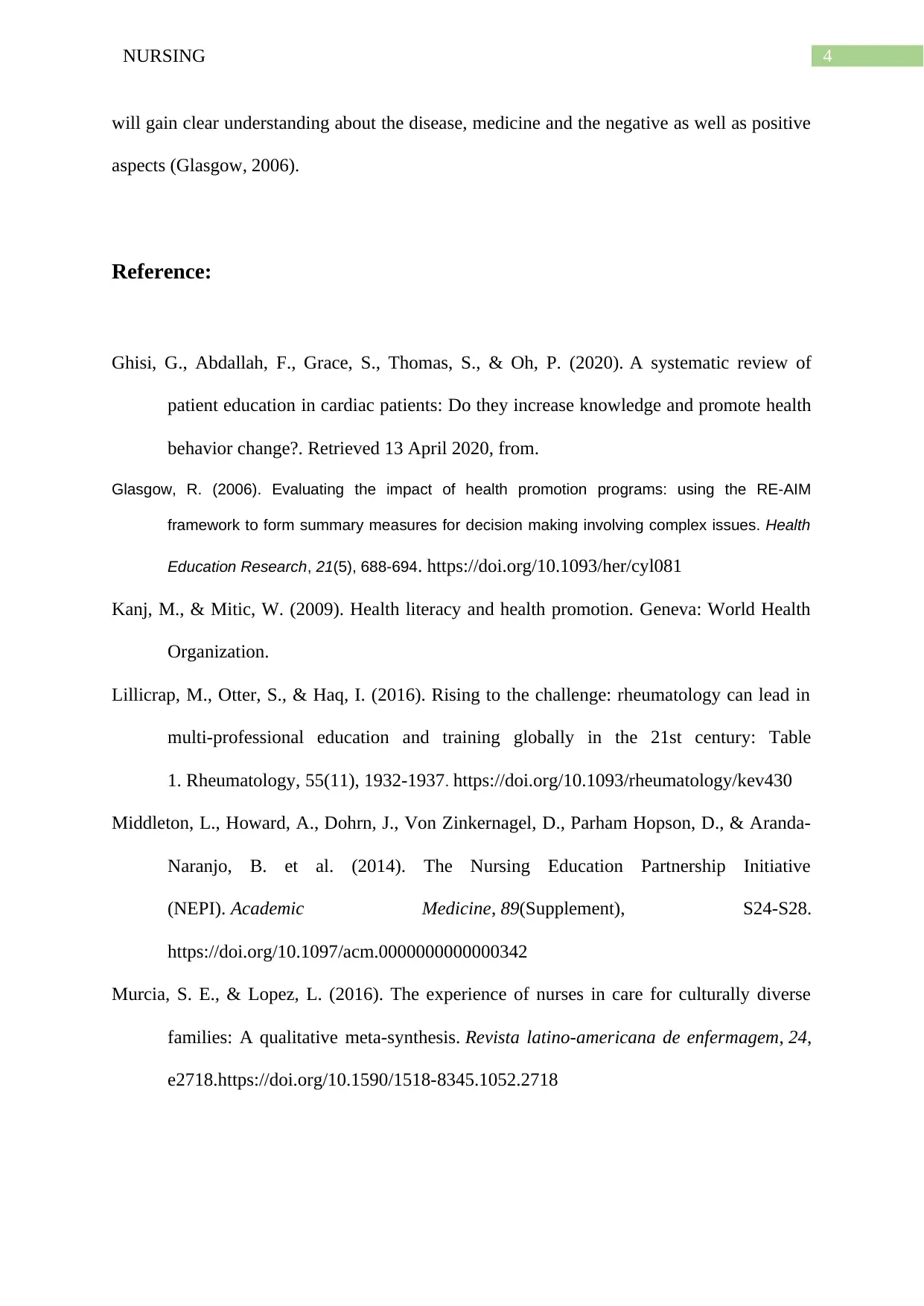
4NURSING
will gain clear understanding about the disease, medicine and the negative as well as positive
aspects (Glasgow, 2006).
Reference:
Ghisi, G., Abdallah, F., Grace, S., Thomas, S., & Oh, P. (2020). A systematic review of
patient education in cardiac patients: Do they increase knowledge and promote health
behavior change?. Retrieved 13 April 2020, from.
Glasgow, R. (2006). Evaluating the impact of health promotion programs: using the RE-AIM
framework to form summary measures for decision making involving complex issues. Health
Education Research, 21(5), 688-694. https://doi.org/10.1093/her/cyl081
Kanj, M., & Mitic, W. (2009). Health literacy and health promotion. Geneva: World Health
Organization.
Lillicrap, M., Otter, S., & Haq, I. (2016). Rising to the challenge: rheumatology can lead in
multi-professional education and training globally in the 21st century: Table
1. Rheumatology, 55(11), 1932-1937. https://doi.org/10.1093/rheumatology/kev430
Middleton, L., Howard, A., Dohrn, J., Von Zinkernagel, D., Parham Hopson, D., & Aranda-
Naranjo, B. et al. (2014). The Nursing Education Partnership Initiative
(NEPI). Academic Medicine, 89(Supplement), S24-S28.
https://doi.org/10.1097/acm.0000000000000342
Murcia, S. E., & Lopez, L. (2016). The experience of nurses in care for culturally diverse
families: A qualitative meta-synthesis. Revista latino-americana de enfermagem, 24,
e2718.https://doi.org/10.1590/1518-8345.1052.2718
will gain clear understanding about the disease, medicine and the negative as well as positive
aspects (Glasgow, 2006).
Reference:
Ghisi, G., Abdallah, F., Grace, S., Thomas, S., & Oh, P. (2020). A systematic review of
patient education in cardiac patients: Do they increase knowledge and promote health
behavior change?. Retrieved 13 April 2020, from.
Glasgow, R. (2006). Evaluating the impact of health promotion programs: using the RE-AIM
framework to form summary measures for decision making involving complex issues. Health
Education Research, 21(5), 688-694. https://doi.org/10.1093/her/cyl081
Kanj, M., & Mitic, W. (2009). Health literacy and health promotion. Geneva: World Health
Organization.
Lillicrap, M., Otter, S., & Haq, I. (2016). Rising to the challenge: rheumatology can lead in
multi-professional education and training globally in the 21st century: Table
1. Rheumatology, 55(11), 1932-1937. https://doi.org/10.1093/rheumatology/kev430
Middleton, L., Howard, A., Dohrn, J., Von Zinkernagel, D., Parham Hopson, D., & Aranda-
Naranjo, B. et al. (2014). The Nursing Education Partnership Initiative
(NEPI). Academic Medicine, 89(Supplement), S24-S28.
https://doi.org/10.1097/acm.0000000000000342
Murcia, S. E., & Lopez, L. (2016). The experience of nurses in care for culturally diverse
families: A qualitative meta-synthesis. Revista latino-americana de enfermagem, 24,
e2718.https://doi.org/10.1590/1518-8345.1052.2718
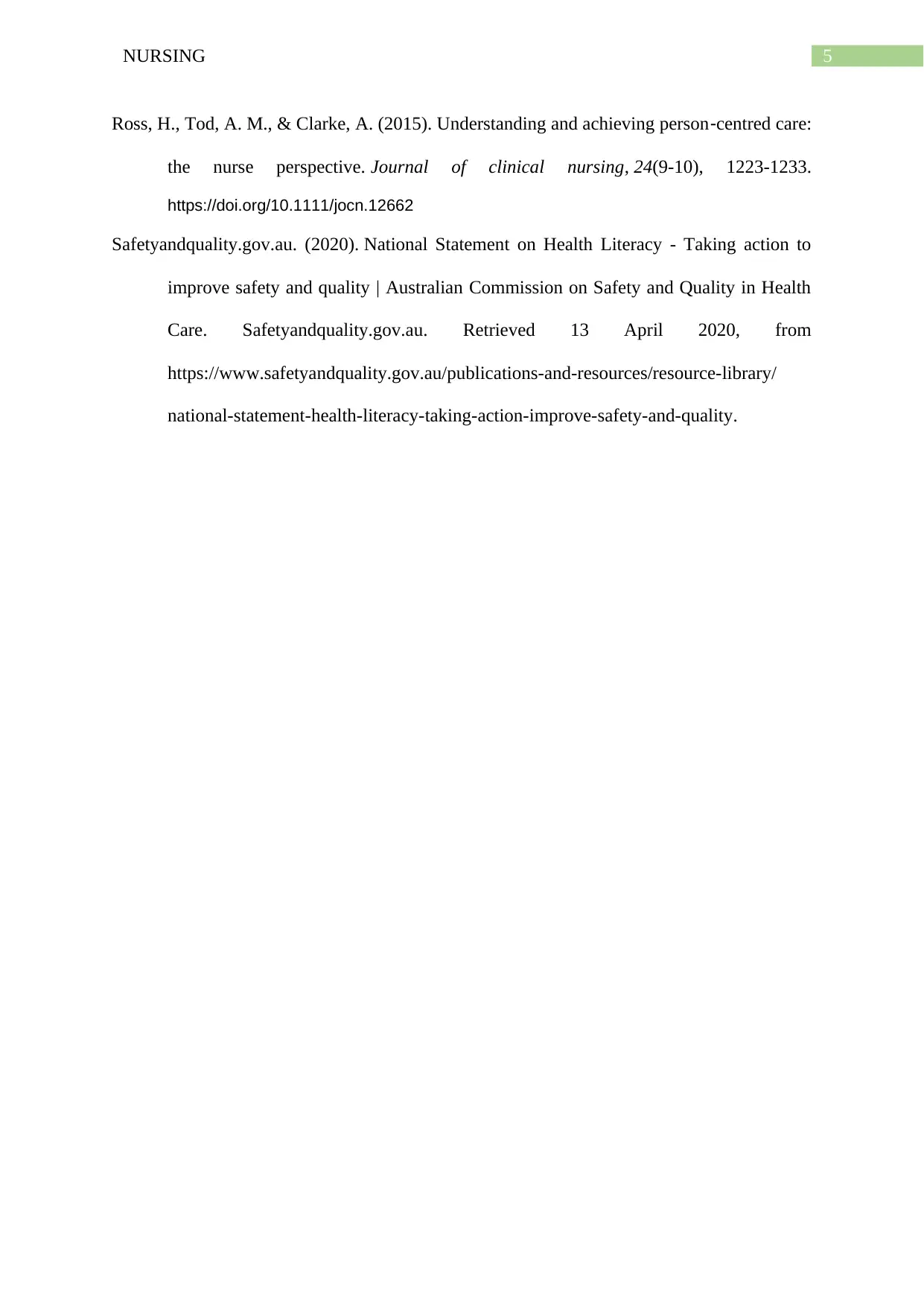
5NURSING
Ross, H., Tod, A. M., & Clarke, A. (2015). Understanding and achieving person‐centred care:
the nurse perspective. Journal of clinical nursing, 24(9-10), 1223-1233.
https://doi.org/10.1111/jocn.12662
Safetyandquality.gov.au. (2020). National Statement on Health Literacy - Taking action to
improve safety and quality | Australian Commission on Safety and Quality in Health
Care. Safetyandquality.gov.au. Retrieved 13 April 2020, from
https://www.safetyandquality.gov.au/publications-and-resources/resource-library/
national-statement-health-literacy-taking-action-improve-safety-and-quality.
Ross, H., Tod, A. M., & Clarke, A. (2015). Understanding and achieving person‐centred care:
the nurse perspective. Journal of clinical nursing, 24(9-10), 1223-1233.
https://doi.org/10.1111/jocn.12662
Safetyandquality.gov.au. (2020). National Statement on Health Literacy - Taking action to
improve safety and quality | Australian Commission on Safety and Quality in Health
Care. Safetyandquality.gov.au. Retrieved 13 April 2020, from
https://www.safetyandquality.gov.au/publications-and-resources/resource-library/
national-statement-health-literacy-taking-action-improve-safety-and-quality.
⊘ This is a preview!⊘
Do you want full access?
Subscribe today to unlock all pages.

Trusted by 1+ million students worldwide
1 out of 6
Related Documents
Your All-in-One AI-Powered Toolkit for Academic Success.
+13062052269
info@desklib.com
Available 24*7 on WhatsApp / Email
![[object Object]](/_next/static/media/star-bottom.7253800d.svg)
Unlock your academic potential
Copyright © 2020–2025 A2Z Services. All Rights Reserved. Developed and managed by ZUCOL.





